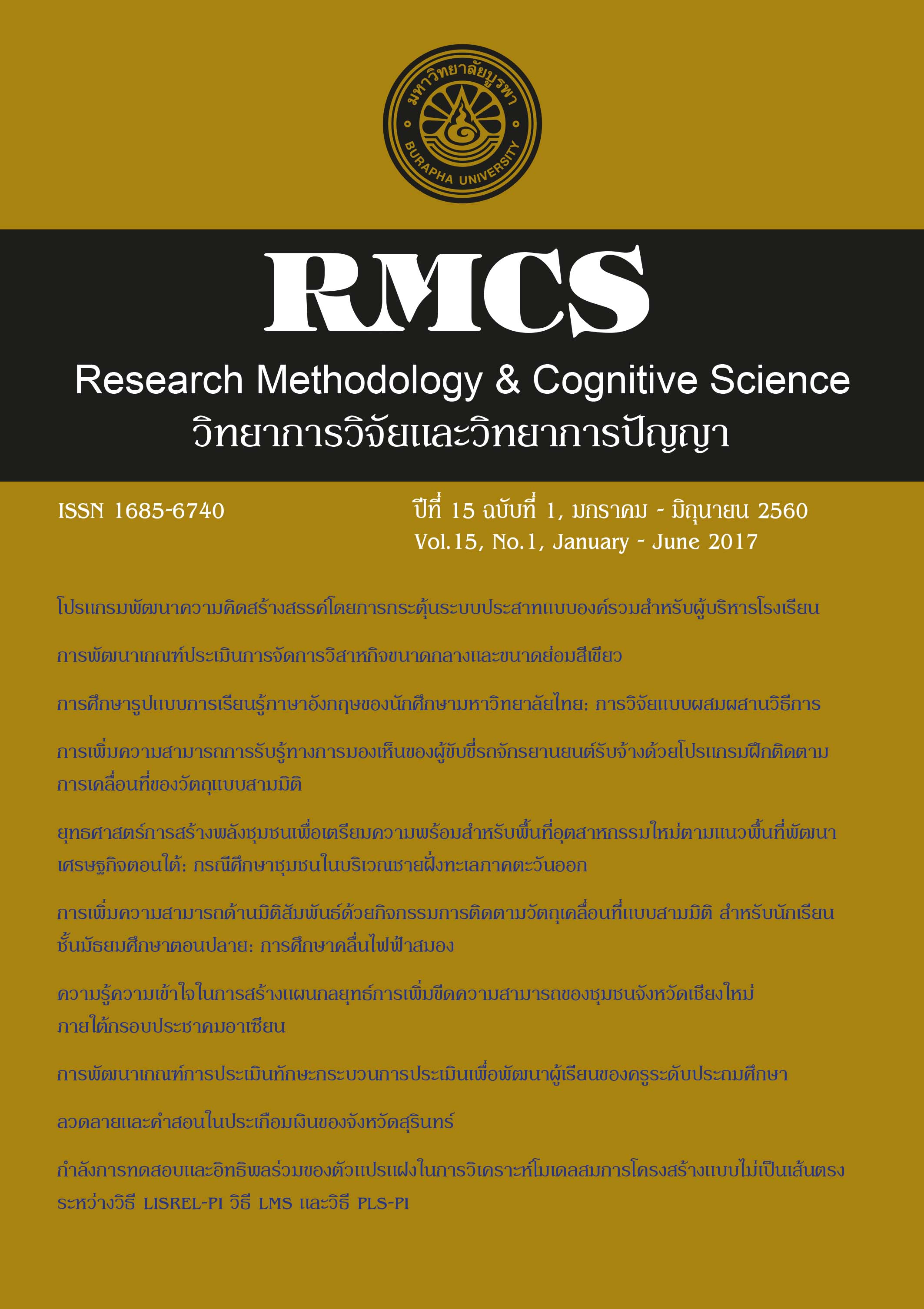โปรแกรมพัฒนาความคิดสร้างสรรค์โดยการกระตุ้นระบบประสาทแบบองค์รวม สำหรับผู้บริหารโรงเรียน Creativity Development Program By Holistic Nervous System Stimulation for School Administrators
Main Article Content
Abstract
ผู้บริหารโรงเรียนมีหน้าที่บริหารทรัพยากรบุคคลในองค์การให้มีประสิทธิภาพ ความคิดสร้างสรรค์เป็นกิจกรรมพื้นฐานของมนุษย์ต่อการประมวลผลทั้งปวงและเป็นที่ยอมรับกันแล้วว่า ลักษณะความคิดสร้างสรรค์เป็นองค์ประกอบสำคัญต่อความสามารถในการทำงาน การวิจัยนี้มีวัตถุประสงค์เพื่อสร้างโปรแกรมพัฒนาความคิดสร้างสรรค์โดยการกระตุ้นระบบประสาทแบบองค์รวมสำหรับผู้บริหารโรงเรียน เปรียบเทียบความคิดสร้างสรรค์ของผู้บริหารโรงเรียนในกลุ่มทดลองระหว่างก่อนกับหลังได้รับโปรแกรมพัฒนาความคิดสร้างสรรค์ และเปรียบเทียบความคิดสร้างสรรค์ของผู้บริหารโรงเรียนกลุ่มทดลองกับกลุ่มควบคุมระยะหลังการทดลอง โดยพิจารณาจากคะแนนความคิดสร้างสรรค์ ความกว้างและความสูงของคลื่นไฟฟ้าสมอง P300 ขณะทำแบบทดสอบความคิดสร้างสรรค์ กลุ่มตัวอย่างเป็นอาสาสมัครผู้บริหารโรงเรียนสังกัดสำนักงานเขตพื้นที่การศึกษาประถมศึกษาสระบุรี เขต 1 จำนวน 60 คน สุ่มเข้ากลุ่มทดลองและกลุ่มควบคุม กลุ่มละ 30 คน เครื่องมือที่ใช้ในการเก็บข้อมูลได้แก่ แบบทดสอบความคิดสร้างสรรค์ของทอร์แรนซ์ (Torrance Tests of Creative Thinking) และโปรแกรมพัฒนาความคิดสร้างสรรค์โดยการกระตุ้นระบบประสาทแบบองค์รวม วิเคราะห์ข้อมูลโดยใช้สถิติ t-test
ผลการวิจัยสรุปได้ว่า 1) ผู้บริหารกลุ่มทดลองหลังได้รับโปรแกรมพัฒนามีคะแนนความคิดสร้างสรรค์สูงกว่าก่อนได้รับโปรแกรมพัฒนา (p < .05) 2) ผู้บริหารกลุ่มทดลองมีความคิดสร้างสรรค์หลังได้รับโปรแกรมพัฒนาสูงกว่ากลุ่มควบคุม (p < .05) และ 3) การเปลี่ยนแปลงของคลื่นไฟฟ้าสมอง ที่ตำแหน่ง FP1, FPZ, FP2, AF3, AF4, F5, F3, F1, FZ, F2, F4, F6, F8, FCZ, FC2, FC4 และ FC6 มีค่าความกว้างและความสูงของคลื่นไฟฟ้า P300 น้อยกว่าก่อนได้รับโปรแกรมพัฒนา และน้อยกว่ากลุ่มควบคุม (p < .05) สรุปได้ว่าโปรแกรมสามารถพัฒนาความคิดสร้างสรรค์ของผู้บริหารโรงเรียนได้
School administrators are responsible for effective school management. Creative thinking is a main human cognitive process for all information processing and this process is an important component for working capacity. The purposes of this research were (1) to create a program for creativity development among school administrators by stimulating the holistic nervous system; (2) to compare the creativity of school administrators in the experimental group before and after training with the program and (3) to compare post-creativity with a control group by considering the creative score, latency and amplitude of the P300 brain waves while doing the creative thinking test. The participants were 60 volunteers, who were school administrators in the Saraburi Primary Educational Service Area Office 1, randomly and equally assigned to experimental and control groups. The research instruments were Torrance Tests of Creative Thinking, and a Creativity Development Program by Holistic Nervous System Stimulation for School Administrators. The data were analyzed using t-tests.
The results showed that (1) The creative score in the experimental group after training was higher than before training (p< .05); (2) The creative score in the experimental group after training was higher than that of the control group (p< .05) and, (3) In terms of the brain function at positions FP1, FPZ, FP2, AF3, AF4, F5, F3, F1, FZ, F2, F4, F6, F8, FCZ, FC2, FC4 and FC6, the latency and amplitude of the P300 in brain wave the experimental group were lower than before training and the control group (p< .05). In conclusion, the program in this study was found to be effective in creativity development among school administrators.
Article Details
References
นันทิกา ทวิชาชาติ. (2551). ออกกำลังสมองก่อนสมองจะเสื่อม. วารสารสมาคมจิตแพทย์แห่งประเทศไทย, 53(1), 152-157.
Christensen, L. B., Johnson, R. B., & Turner, L. A. (2011). Research Methods, Design,and Analysis (11th ed.). Boston, Massachusetts: Pearson.
Di Noto, P., Uta, S., & DeSouza, J. F. X. (2013). Eye Exercises Enhance Accuracy and Letter Recognition, but Not Reaction Time, in a Modified Rapid Serial Visual Presentation Task. PLoS ONE, 8(3), 1-9.
Gupta, V., Singh, S., & Khatri, N. (2013). Creativity in research and development laboratories: A new scale for leader behaviours. IIMB Management Review, 25(2), 83-90.
Hassan, F., Sadowski, L. S., Bangdiwala, S. I., Vizcarra, B., Ramiro, L., De Paula, C. S., & Mitra, M. K. (2004). Physical intimate partner violence in Chile, Egypt, India and the Philippines. Injury Control and Safety Promotion, 11(2), 111-116.
Herrmann, C. S., & Knight, R. T. (2010). Mechanisms of human attention: Event-related potentials and oscillations. Neuroscience & Biobehavioral Reviews, 25(6), 465-476.
Hillyard, S. A., & Anllo-Vento, L. (2008). Event-related brain potentials in the study of visual selective attention. Proceedings of the National Academy of Sciences, 95(3), 781-787.
Katz, D., & Kahn, R. L. (1978). The social psychology of organization (2nd ed.). New York: John Wiley and Sons.
Katz, N., & Tao, T. (2002). New bounds for Kakeya problems. Journal d'Analyse Mathématique, 87(1), 231-263.
Luck, S. J., & Gold, J. M. (2008). The construct of attention in schizophrenia. Biol Psychiatry, 64(1), 34-39.
Onarheim, B., & Friis-Olivarius, M. (2013). Applying the neuroscience of creativity to creativity training. Frontiers in Human Neuroscience, 7, 656.
Organ, P.A. (2010). Exercise in schools can help children pay attention in The classroom. journal Developmental Medicine and Child Neurology, 19, 220-245.
Tang, Y. Y., Ma, Y., Wang, J., Fan, Y., Feng, S., Lu, Q., & Posner, M. I. (2007). Short-term meditation training improves attention and self-regulation. Proceedings of the National Academy of Sciences, 104(43), 17152-17156.
Torrance, E. P., (2006). Research review for the Torrance tests of creative thinking figural and verbal forms A and B. Bensenville, Illinois: Scholastic Testing Service.
Kriengkaisakda, W., & Chadcham, S. (2012). Development of a Brain-Training Rehabilitation Program Based on Neurobics Exercise Theory for Patients with Mild Dementia. Research Methodology & Cognitive Science, 10(1), 11-25.
Wolfsont, C. (2002). Behavioral Skills and Level of Understanding in Adults: A Brief Method Integrating Dennison's Brain Gym Balance with Piaget's Reflective Processes. Journal of Adult Development, 9(15), 187-203.

